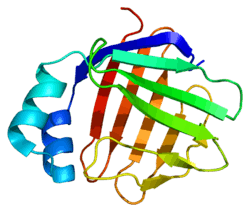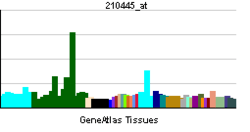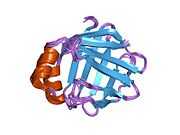FABP6
Fatty acid binding protein 6, ileal (gastrotropin), also known as FABP6, is a protein which in humans is encoded by the FABP6 gene.[1]
Function
This gene encodes the ileal fatty acid binding protein. Fatty acid binding proteins are a family of small, highly conserved, cytoplasmic proteins that bind long-chain fatty acids and other hydrophobic ligands. FABP6 and FABP1 (the liver fatty acid binding protein) are also able to bind bile acids. It is thought that FABPs roles include fatty acid uptake, transport, and metabolism. Transcript variants generated by alternate transcription promoters and/or alternate splicing have been found for this gene.[1]
References
Further reading
- Börchers T, Hohoff C, Buhlmann C, Spener F (1997). "Heart-type fatty acid binding protein - involvement in growth inhibition and differentiation.". Prostaglandins Leukot. Essent. Fatty Acids 57 (1): 77–84. doi:10.1016/S0952-3278(97)90496-8. PMID 9250612.
- Fujita M, Fujii H, Kanda T et al. (1995). "Molecular cloning, expression, and characterization of a human intestinal 15-kDa protein.". Eur. J. Biochem. 233 (2): 406–13. doi:10.1111/j.1432-1033.1995.406_2.x. PMID 7588781.
- Oelkers P, Dawson PA (1995). "Cloning and chromosomal localization of the human ileal lipid-binding protein.". Biochim. Biophys. Acta 1257 (2): 199–202. doi:10.1016/0005-2760(95)00098-w. PMID 7619861.
- Birkenmeier EH, Rowe LB, Crossman MW, Gordon JI (1995). "Ileal lipid-binding protein (Illbp) gene maps to mouse chromosome 11.". Mamm. Genome 5 (12): 805–6. doi:10.1007/BF00292019. PMID 7894165.
- Watanabe K, Hoshi N, Tsuura Y et al. (1996). "Immunohistochemical distribution of intestinal 15 kDa protein in human tissues.". Arch. Histol. Cytol. 58 (3): 303–6. doi:10.1679/aohc.58.303. PMID 8527237.
- Lücke C, Zhang F, Rüterjans H et al. (1997). "Flexibility is a likely determinant of binding specificity in the case of ileal lipid binding protein.". Structure 4 (7): 785–800. doi:10.1016/S0969-2126(96)00086-X. PMID 8805562.
- Grober J, Zaghini I, Fujii H et al. (1999). "Identification of a bile acid-responsive element in the human ileal bile acid-binding protein gene. Involvement of the farnesoid X receptor/9-cis-retinoic acid receptor heterodimer.". J. Biol. Chem. 274 (42): 29749–54. doi:10.1074/jbc.274.42.29749. PMID 10514450.
- Seibert C, Harteneck C, Ernst OP et al. (2000). "Activation of the rod G-protein Gt by the thrombin receptor (PAR1) expressed in Sf9 cells.". Eur. J. Biochem. 266 (3): 911–6. doi:10.1046/j.1432-1327.1999.00927.x. PMID 10583385.
- Lücke C, Zhang F, Hamilton JA et al. (2000). "Solution structure of ileal lipid binding protein in complex with glycocholate.". Eur. J. Biochem. 267 (10): 2929–38. doi:10.1046/j.1432-1327.2000.01307.x. PMID 10806391.
- Strausberg RL, Feingold EA, Grouse LH et al. (2003). "Generation and initial analysis of more than 15,000 full-length human and mouse cDNA sequences". Proc. Natl. Acad. Sci. U.S.A. 99 (26): 16899–903. doi:10.1073/pnas.242603899. PMC 139241. PMID 12477932.
- Kurz M, Brachvogel V, Matter H et al. (2003). "Insights into the bile acid transportation system: the human ileal lipid-binding protein-cholyltaurine complex and its comparison with homologous structures". Proteins 50 (2): 312–28. doi:10.1002/prot.10289. PMID 12486725.
- Barley NF, Taylor V, Shaw-Smith CJ et al. (2004). "Human ileal bile acid-binding protein promoter and the effects of CDX2". Biochim. Biophys. Acta 1630 (2–3): 138–43. doi:10.1016/j.bbaexp.2003.09.008. PMID 14654244.
- Ota T, Suzuki Y, Nishikawa T et al. (2004). "Complete sequencing and characterization of 21,243 full-length human cDNAs". Nat. Genet. 36 (1): 40–5. doi:10.1038/ng1285. PMID 14702039.
- Gerhard DS, Wagner L, Feingold EA et al. (2004). "The Status, Quality, and Expansion of the NIH Full-Length cDNA Project: The Mammalian Gene Collection (MGC)". Genome Res. 14 (10B): 2121–7. doi:10.1101/gr.2596504. PMC 528928. PMID 15489334.
- Landrier JF, Thomas C, Grober J et al. (2005). "The gene encoding the human ileal bile acid-binding protein (I-BABP) is regulated by peroxisome proliferator-activated receptors". Biochim. Biophys. Acta 1735 (1): 41–9. doi:10.1016/j.bbalip.2005.05.002. PMID 15936983.
- Rual JF, Venkatesan K, Hao T et al. (2005). "Towards a proteome-scale map of the human protein-protein interaction network". Nature 437 (7062): 1173–8. doi:10.1038/nature04209. PMID 16189514.
- Bergheim I, Harsch S, Mueller O et al. (2006). "Apical sodium bile acid transporter and ileal lipid binding protein in gallstone carriers". J. Lipid Res. 47 (1): 42–50. doi:10.1194/jlr.M500215-JLR200. PMID 16237211.
- Ohmachi T, Inoue H, Mimori K et al. (2007). "Fatty acid binding protein 6 is overexpressed in colorectal cancer". Clin. Cancer Res. 12 (17): 5090–5. doi:10.1158/1078-0432.CCR-05-2045. PMID 16951225.
- Fang C, Dean J, Smith JW (2007). "A novel variant of ileal bile acid binding protein is up-regulated through nuclear factor-kappaB activation in colorectal adenocarcinoma". Cancer Res. 67 (19): 9039–46. doi:10.1158/0008-5472.CAN-06-3690. PMID 17909007.
PDB gallery |
|---|
| | 1o1u: human ileal lipid-binding protein (ILBP) in free form |
| 1o1v: Human Ileal Lipid-Binding Protein (ILBP) in Complex with Cholyltaurine |
|
|
|
|
|---|
| | Fatty acid | |
|---|
| | Hormone | |
|---|
| | Metal/element | |
|---|
| | Vitamin | |
|---|
| | Other | |
|---|
| |
|---|
| | Description |
- Proteins
- Membrane
- Globular
- Antibodies
- Fibrous
|
|---|
|
|



